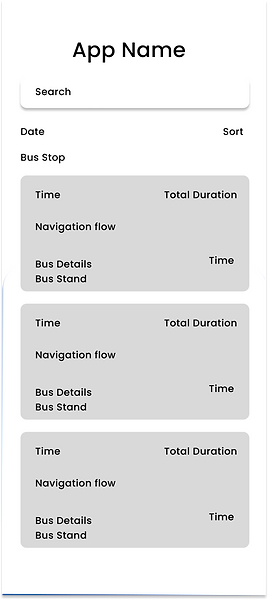Swift Route
Swift Route is a real-time public transport app that provides live bus tracking, disruption alerts, and alternative routes to ensure seamless commuting. It notifies users of delays or outages and suggests the fastest available route.

My Role
I was responsible for user research, product design, wireframes, interactive prototypes, and visual design.
What I do
-
Create a user flow using Agile Methodologies for a smooth process.
-
Conduct User Research to create optimal products for users.
-
Work together with stakeholders and ensure to understand the requirements goal and objective.
-
Conducted !:1 interviews with the users to iterate and refine the designs.
-
Work together with the front-end and back-end teams to determine the best possible solutions.
Requirement
The stakeholders highlighted a key requirement: users need real-time public transport tracking to stay updated on bus/tram movements and plan their schedules in advance efficiently
Problem Statement
-
People desire live arrival/departure times and up-to-date information on traffic issues or disruptions.
-
People want to see alternative routes in case of disruptions.
-
People wish to be informed about planned outages, such as those due to maintenance work.
-
People are looking for a route planner that shows which buses can take them from point A to point B
Process
To help untangle the messiness of ambiguity and give some structure to solving the problems I followed the below process:
0 1
Empathize
Initial Discussion with Stakeholders
1. Stakeholder Interviews: I engaged with key stakeholders to gather insights into business goals, user challenges, and potential solutions. These discussions provided clarity on user pain points, such as the lack of real-time tracking and difficulties in planning commutes efficiently.
2. Value Proposition Mapping: To define the core functionalities, I conducted a value proposition mapping exercise. This helped identify:
-
What the feature is (real-time tracking, disruption alerts, route planning)
-
Who will use it (daily commuters, tourists, accessibility users)
-
Why they will use it (to reduce uncertainty and improve travel planning)
This process ensured alignment between user expectations and business priorities.
Market Research
I started with the market research to understand the trends going on in the market
1. Competitor Analysis
I examined popular public transport and navigation apps, including:
-
Google Maps – Strong in route planning but lacks proactive disruption alerts.
-
Moovit – Provides real-time tracking but has a cluttered interface.
-
Transit App – Good for live tracking but limited in alternative route suggestions.
-
SL (Stockholm’s Public Transport App) – Official local transit app but lacks personalized notifications.
2. Industry Trends & Best Practices
-
Real-time data integration is crucial for public transport apps.
-
AI-powered route optimization is emerging as a key feature.
-
Personalized push notifications improve user engagement.
-
Accessibility features (voice assistance, easy readability) are becoming standard.
Key Findings
-
Most apps provide live tracking but fail to offer proactive disruption alerts.
-
Alternative route suggestions are often not user-friendly.
-
UI/UX inconsistencies make navigation difficult for new users.
0 2
Define
In this phase, I synthesized the insights gathered from the empathize stage to clearly define the problem statement, user needs, and key challenges. This step helped in creating a structured approach to designing an effective solution.

0 3
Ideate
In this phase, I explored different design possibilities and sketched initial concepts to visualize potential solutions. The goal was to brainstorm, iterate, and refine ideas before moving into detailed design.
I started with rough sketches to map out key screens, ensuring a logical user flow and intuitive navigation. This step helped align the design direction with user needs and business goals.
Concept Sketching


Low Fidelity Wireframes
I started with rough sketches to map out key screens, ensuring a logical user flow and intuitive navigation. This step helped align the design direction with user needs and business goals.



0 5
UI Designs
Finally I transformed low-fidelity wireframes into high-fidelity UI designs, focusing on usability, accessibility, and aesthetics. The goal was to create a polished, intuitive, and visually engaging experience for users.I incorporated consistent design components, color schemes, and typography to enhance clarity and readability.
Special attention was given to autolayout, scalable components, and accessibility best practices to ensure a seamless experience across different devices.
The final UI reflects a modern, user-friendly interface that enables users to track buses in real time, receive disruption alerts, and find alternate routes effortlessly
